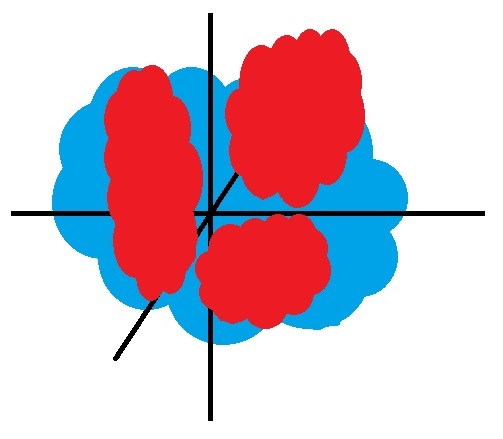I read Douglas Hofstadter’s Surfaces and Essences: Analogy as the Fuel and Fire of Thinking a few months ago, and, although I wouldn’t recommend it as enthusiastically as Gödel Escher Bach, there was one section I was delighted to read. It felt like Hofstadter had crystallized a very important part of my thinking process and set it down on paper.
We would like to offer a simple visual metaphor for thinking about the words of a language and the concepts they represent. We begin by suggesting that you imagine a two-dimensional space or a three-dimensional one, as you prefer; next, we are going to start filling that space up, in our imagination, with small patches of color, using a different color for each different language we are interested in…
How is a conceptual space filled up with sets of blobs of different colors? For instance, how do the repertoires of concepts possessed by French and English speakers who share essentially the same culture compare?
…Some of the different-colored blobs representing different languages’ coverages of a given extremely frequent concept will tend to have pretty much the same shape, but in the case of other blobs, there will be discrepancies, some minor and some major. We’ve already seen a pretty major one, involving time corresponding to heur, temps, and fois and temps corresponding to both time and weather…
Thus, the center of this conceptual space is inhabited by red and green blobs that often coincide quite well, and, when they don’t coincide, then there are all sorts of overlapping blobs, each with its own curious shape… Let’s take any shell of this conceptual space. Since languages differ enormously, we can easily find a red blog that no single green blog covers precisely. However, a small set of green blobs will collectively do a pretty good job covering all the territory of the red blob (although they will inevitably also cover areas outside the red blob)…
In summary, when language A has a word that strikes its speakers as representing a natural and monolithic concept, and language B has no corresponding word, then language B is poorer and language A is richer, because speakers of language B are forced to cobble different words together in order to cover the zone of conceptual space that language A covers with just one word. Conversely, when language B has a set of words that cut up a zone of conceptual space that is covered by just one word in language A, and when the distinctions offered by language B seem natural to speakers of both languages, then it’s language B that is richer and language A that is poorer.
Just reading this section of Hofstadter’s book was like the experience of finding out that another language has had one blob for my collection of patchworked blobs all this time. For me, this visual metaphor lights up an important region in my conceptual space.
This happens less to me on the level of words, and more often when reading books and suddenly finding a peg for an idea or an emotion that hadn’t felt as unified before my one big blue blog appears as a superset of my little red approximations. So, when I see Sunday in the Park with George, I might realize that “Finishing the Hat” is a metonym for a whole set of experiences where I wind up doing something fairly abstract or creative and end up feeling both energized and lonely à la:
I like that Hofstadter chose the analogy of translation between languages to start talking about analogies generally. Because when I find out that someone doesn’t have the big blue blob of one of my conceptual touchstones in their personal experiential lexicon, I feel as clumsy expressing my ideas as when my ASL teacher asked me to justify my then-atheism using my five-month-old vocabulary.
Thus, I really like arguments framed as book clubs, inviting my friends over for movies, or just sending my gentleman caller a youtube link to a particular musical theatre song when I need to explain the particular way I’m upset. It’s a way of giving someone else a crash course in your internal language and to avoid some of the pitfalls of false cognates. And now, thanks to Hofstadter, I’ve gotten to share another of my core vocabulary ideas with you
P.S. Over at the CFAR blog, I had a post up a few weeks ago on which rationality/cognitive science ideas are easier to express in languages other than English.













